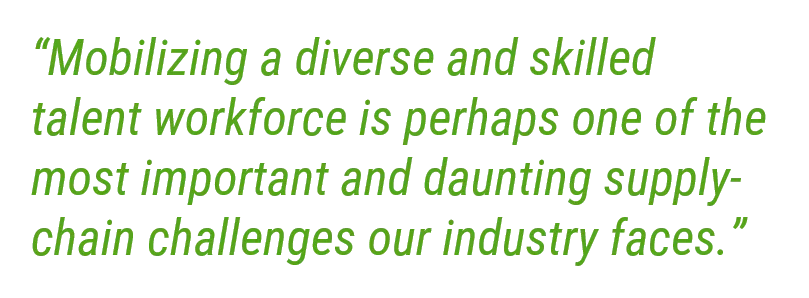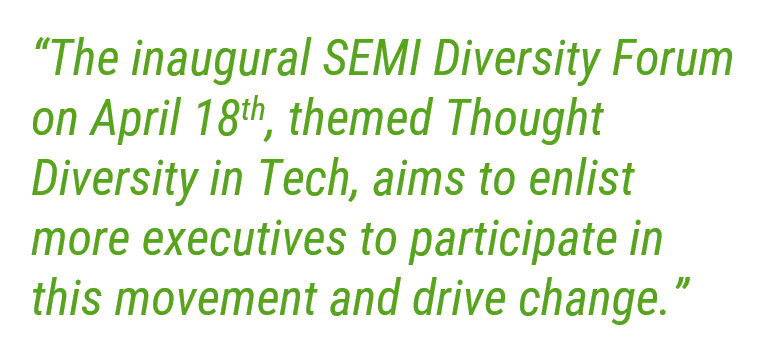
My thoughts about diversity are rooted in a couple of core beliefs.
First, that innovation in the semiconductor supply chain is essential. While cost, quality and service are vital, it is technological advancement that distinguishes this year’s killer applications from the once shining stars of prior generations. Practically speaking, the promise of Moore’s Law is less about a specific rate or dimension than a principle of continuous advancement.
Secondly, innovation and the resulting intellectual property is completely dependent on highly skilled and well-educated individuals. We are a smart industry. We need smart people.
As vertical electronics applications, markets and end products become ever smarter, the need for skilled talent in the microelectronics manufacturing supply chain intensifies. And these days, it is harder to attract and retain the brains and skills needed to keep our industry moving. Stiff competition for talent from other technology sectors deepens the challenge.
 While we anticipate a softer market in 2019, the long-term outlook remains bullish due to an unprecedented number of disruptions and their promise to drive tremendous industry growth. What's more, the complexity of microelectronic products and the increasing variety of global market applications requires an expanding range of awareness, insights and consumer sensitivities. These dynamics make mobilizing a diverse and skilled talent workforce perhaps one of the most important and daunting supply-chain challenges our industry faces.
While we anticipate a softer market in 2019, the long-term outlook remains bullish due to an unprecedented number of disruptions and their promise to drive tremendous industry growth. What's more, the complexity of microelectronic products and the increasing variety of global market applications requires an expanding range of awareness, insights and consumer sensitivities. These dynamics make mobilizing a diverse and skilled talent workforce perhaps one of the most important and daunting supply-chain challenges our industry faces.
There is little question about the critical industry need to foster diversity and inclusion. A mountain of research has confirmed that diverse organizations perform better1, are better at innovation, better at retaining talent2, are more satisfying places of employment, and more likely to succeed in new markets3.

Fortune 500 companies with a higher representation of women on their boards of directors have 53 percent greater returns on equity, and 42 percent greater returns on sales.4
Beyond the fundamental issue of fairness, diversity makes good business sense. No one disagrees.
To be sure, there are leaders in the movement. In January 2015, Intel set a goal to reach full representation of women and underrepresented minorities in its U.S. workforce by 2020. After committing $300 million to support this goal, Intel achieved full representation two years ahead of schedule. According to press reports, the Intel workforce now reflects the proportion of women and underrepresented minorities available in the U.S. skilled labor market.6
Notably, Intel has integrated diversity and inclusion into its business processes. Diversity is incorporated in its business goals and inclusion metrics are incorporated into the company’s strategy, annual performance goals and bonus structure.
 Applied Materials recently made the bold move to publicly report diversity statistics with the publication of its first annual Applied Materials Diversity and Inclusion Report. Within the report, the company acknowledges that “Globally, the representation of women in our workforce has remained relatively flat. However, by focusing our efforts on increasing the number of women in our U.S. population, we have seen steady positive movement.” The point is – it is being open and transparent and has set a path to positive change.
Applied Materials recently made the bold move to publicly report diversity statistics with the publication of its first annual Applied Materials Diversity and Inclusion Report. Within the report, the company acknowledges that “Globally, the representation of women in our workforce has remained relatively flat. However, by focusing our efforts on increasing the number of women in our U.S. population, we have seen steady positive movement.” The point is – it is being open and transparent and has set a path to positive change.
Yet, our industry is plagued by an inability to make its workforce significantly more diverse. What’s worse, a recent McKinsey Global Institute report says that progress on diversity has stalled. To achieve equality, companies must turn good intentions into concrete action.5
Following on the pledge I made a year ago, SEMI aspires to leverage its broad leadership role to be a catalyst for action.
SEMI and the SEMI Foundation are in a unique position to drive industry diversity. Our mission-driven purpose allows us to promote industry-wide collaboration in ways that individual companies can’t.
 This purpose resonates with our goal to advance industry growth and support our members’ business interests, and it includes promoting fairness and equality while improving the appeal of our industry to future innovators of all physical abilities, cultures, races, and intellectual and gender orientations.
This purpose resonates with our goal to advance industry growth and support our members’ business interests, and it includes promoting fairness and equality while improving the appeal of our industry to future innovators of all physical abilities, cultures, races, and intellectual and gender orientations.
With this article, I am declaring a new call to action toward significant and measurable progress on diversity and inclusion in our industry. The issue extends far beyond gender parity and SEMI is committed to a broad-based diversity program. As outlined below, some of our immediate programs are designed to advance the role of women in our industry.
In the past year, I’ve communicated a Diversity Pledge, SEMI has formed new member-driven Diversity and Inclusion Councils in regions where we operate, we’ve mandated inclusion of more women speakers at our events, we’ve identified gender diversity as a key component of an overall workforce development strategy, we’ve launched a new Spotlight on SEMI Women recognition program to motivate and inspire students and working women, and we’ve rolled out a mentoring program and held women’s forums and numerous other events – such as the Diversity: Women in Tech Breakfast at the recent FLEX 2019 Conference.
Going forward, SEMI will pursue the following initiatives to help drive greater diversity:
- Commitment to diversity principles. Through a voluntary best-practice sharing program, SEMI will mobilize like-minded industry leaders to publicly share their commitment to and accountability for industry diversity.
- Industry-wide data gathering and reporting, including a drive to develop diversity metrics. Under the premise that “you can only change what you can measure,” SEMI will aggregate industry employment and diversity statistics to monitor progress toward a greater representation of women working in the industry.
- Support for manufacturing ownership diversity. SEMI supports a small group of leading companies that will develop diversity standards to promote greater diversity among manufacturing company owners in the supply chain.
We’re also about to kick off a significant new program. On April 18th at SEMI global headquarters in Milpitas, California, we’ll hold the inaugural SEMI Diversity Forum themed Thought Diversity in Tech. The program aims to enlist more executives to participate in this movement and drive change.
 The event keynoter, Alexis Krivkovich, is a Managing Partner at McKinsey and co-authored with LeanIn.org a pivotal report titled Women in the Workplace. She will talk about the report findings and how the industry, in the interest of developing solutions, can use data to better understand the causes of gender equality in the workplace and the dearth of women in leadership positions.
The event keynoter, Alexis Krivkovich, is a Managing Partner at McKinsey and co-authored with LeanIn.org a pivotal report titled Women in the Workplace. She will talk about the report findings and how the industry, in the interest of developing solutions, can use data to better understand the causes of gender equality in the workplace and the dearth of women in leadership positions.
A panel will explore The Different Faces of Diversity and Unconscious Bias. Executives from Intel, Daang Capital, TEL, Rogue Valley Microdevices, Ericsson and Edwards Vacuum – each with a unique, powerful and visionary insight – will discuss the corporate implications and strategies for meaningful diversity programs while covering a range of issues that take into account veterans, people of color, women and exceptional young people.
Please join me and be a part of this change. For more information on the SEMI Diversity Forum and to register, please click here.
Please also join our events, help sponsor our diversity programs and look for more exciting developments in the weeks and months ahead.
The future of our industry is limitless – but only if we embrace its full potential.
Ajit Manocha is president and CEO of SEMI.
Citations
- https://www.weforum.org/agenda/2018/11/inclusion-and-diversity-isnt-just-good-for-employees-its-good-for-the-bottom-line/
- Muhammad Ali, Isabel Metz, and Carol T. Kulik, “Retaining a Diverse Workforce: The Impact of Gender-Focused Human Resource Management,” Human Resource Management Journal, vol. 25, no. 4 (2015): p. 580-599.
- https://www.weforum.org/agenda/2018/11/inclusion-and-diversity-isnt-just-good-for-employees-its-good-for-the-bottom-line/
- https://www.catalyst.org/media/companies-more-women-board-directors-experience-higher-financial-performance-according-latest
- https://www.mckinsey.com/featured-insights/gender-equality/women-in-the-workplace-2018
- https://www.forbes.com/sites/jillgriffin/2018/12/03/two-years-ahead-of-schedule-intels-diversity-inclusion-campaign-has-major-traction/#2fa25e816fdf